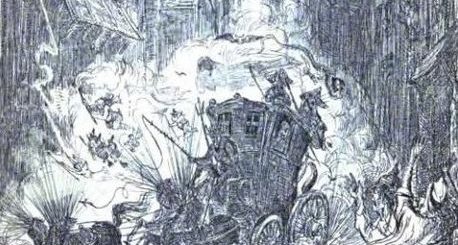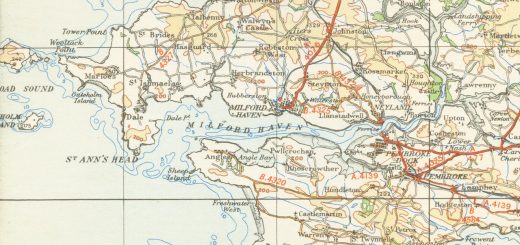Church of St Mor and St Deiniol, Llanfor
The Grade II listed listed of Church of St Mor and St Deiniol in Llanfor is no longer a place of worship and has been recently been advertised for sale. Built in 1875 on the site of a much older building, possibly the oldest church in Merioneth. It is possible that this older church was reputed to have been haunted. Writing in 1887, Elias Owen in his ‘Welsh folk-lore: a collection of the folk-tales and legends of North Wales’ gives the following account which was entitled ‘The Ejectment of the Evil Spirit from Llanfor Church’.
‘Mr. Roberts states that his grandmother, born in 1744, had only traditions of this spirit. He was said to have worn a three-cocked hat, and appeared as a gentleman, and whilst divine service was performed he stood up in the church. But at night the church was lit up by his presence, and the staves between the railings of the gallery were set in motion, by him, like so many spindles, although they were fast in their sockets. He is not reported to have harmed any one, neither did he commit any damage in the church. It is said, he had been seen taking a walk to the top of Moel-y-llan, and although harmless he was a great terror to the neighbourhood, and but few would venture to enter the church alone. Mr. Roberts was told that on a certain occasion a vestry was held in a public house, that stood on p. 163the north side of the church, not a vestige of which now remains, but no one would go to the church for the parish books. The landlady had the courage to go but no sooner had she crossed the threshold than the Evil Spirit blew the light out; she got a light again, but this also was blown out. Instead of returning for another light, she went straight to the coffer in the dark, and brought the books to the house, and that without any molestation.
![Llywelyn2000 [CC BY-SA 4.0 (https://creativecommons.org/licenses/by-sa/4.0)], from Wikimedia Commons](http://www.mysteriousbritain.co.uk/wp/wp-content/uploads/2018/11/1280px-Sant_Mor_a_Sant_Deiniol_-_St_Mor_and_St_Deiniol_37-300x200.jpg) Mr. Roberts states that as the Spirit of darkness became more and more troublesome, it was determined to have him removed, and two gentlemen skilled in divination were called to offer him to Llyn-y-Geulan-Goch. These men were procured and they entered the church in the afternoon and held a conversation with the Spirit, and in the end told him that they would call at such an hour of the night to remove him to his rest. But they were not punctual and when they entered they found him intractable, however, he was compelled to submit, and was driven out of the church in the form of a cock, and carried behind his vanquisher on horseback, and thrown into Llyn-y-Geulan-Goch.
Mr. Roberts states that as the Spirit of darkness became more and more troublesome, it was determined to have him removed, and two gentlemen skilled in divination were called to offer him to Llyn-y-Geulan-Goch. These men were procured and they entered the church in the afternoon and held a conversation with the Spirit, and in the end told him that they would call at such an hour of the night to remove him to his rest. But they were not punctual and when they entered they found him intractable, however, he was compelled to submit, and was driven out of the church in the form of a cock, and carried behind his vanquisher on horseback, and thrown into Llyn-y-Geulan-Goch.
According to tradition the horse made the journey from the church to the pool by two leaps. The distance was two fields’ breadth.
On their arrival at the river side, a terrible struggle ensued, the Fiend would not submit to be imprisoned, and he made a most determined attempt to drag his captors into the water. He, however, by and by, agreed to enter his prison on the condition that they would lie on their faces towards the ground when he entered the river, this they did, and the Spirit with a splash jumped into the water.
Mr. Roberts further states, that there was a tradition in those parts, that the horse which carried the Devil to the river left the impression of his hoof in a stone by the river side, p. 164but Mr. Roberts assures me that he could never discover this stone, nor did he know of any one who had seen it.
The case of the imprisoned Spirit was not hopeless—tradition says he was to remain in the pool only until he counted all the sand in it. It would almost appear that he had accomplished his task, for Mr. Roberts says that he had heard that his father’s eldest brother whilst driving his team in the dead of night through Llanfor village saw two pigs walking behind the waggon. He thought nothing of this, and began to apply his whip to them, but to no purpose, for they followed him to Llyn-y-Geulan-Goch, and then disappeared.
There was in these latter times some dispute as to the Spirit being still in the pool. This, however, has been settled in the affirmative. A wise man, in company with others, proceeded to the river, and threw a stone with writing on it into the pool, but nothing came of it, and he then affirmed there was no spirit there. This the people would not believe, so he threw another stone into the water, and now the river boiled up and foamed. “Yes,” said the sceptic, “he is there, and there he will remain for a long time.”
Such is Mr. Roberts’s account.
Llyn-y-Geulan-Goch is a pool in the river Dee, about a quarter of a mile from Llanfor village.
For the purpose of showing how variously tales are narrated, I will give another version of this haunted church, which was taken down by me from the mouth of an aged woman, a native of the village, whose life had been spent among her own people, and who at present lives in a little cottage on the road side between Llanfor Rectory and Bala. Her name is Ann Hughes, she firmly believes the story, but she could not tell how long ago the spirit was driven out of the church, though she thought it was in her grandfather’s days. Her tale was as follows:—
The Evil Spirit was heard but not seen by the people, and he was in the habit of coming down the pathway leading from Rhiwlas to the church, making a great noise, as if dragging after him chains, or wheeling a wheelbarrow, and he went straight into the church, and there he stayed all night lighting up the church and making a great noise, as though engaged in manual labour. There was then a pathway leading to a row of houses situated in the church yard on the north side, and the people who occupied those cottages dared not leave them the live-long night, in fact the whole village avoided that, and every other path in the neighbourhood of the church, whilst the Spirit was in the church, and every one could see when he was there. At last the disturbance was so great that the parson and another man determined to lay the Spirit, and therefore one night they walked three times round the church, and then went into it, and by and by three men were seen emerging from the church and they walked into the public house through the door that opened into the church yard and they went together into the little parlour. The parson had already given instructions that no one was to come to them on any account, nor even to try to get a glimpse of them; but there was a man in the house who went to the keyhole of the parlour and, looking into the room, saw distinctly three men sitting round the table. No sooner, however, had he done so than the parson came out and said if anyone looked through the keyhole again their plans would be frustrated. This put a stop to all further inquisitiveness, and their deliberations were not again interrupted.
Ann Hughes could not tell me what plan was adopted to get rid of the Evil Spirit, but she knew this much, that he was laid in Llyn-y-Geulan-Goch, and that he was to remain there until a lighted candle, which was hidden somewhere p. 166in the church, when the Spirit was overcome, should go out. Often and again had she searched for this taper, but failed to discover it, but she supposes it is still burning somewhere, for the Evil One has not yet escaped from the pool.
There is a version of the ejectment of Llanfor Spirit given in Y Gordofigion, which is somewhat as follows:—
Llanfor Spirit troubled the neighbourhood of Bala, but he was particularly objectionable and annoying to the inhabitants of Llanfor, for he had taken possession of their Church. At last, the people were determined to get rid of him altogether, but they must procure a mare for this purpose, which they did. A man riding on the mare entered the Church with a friend, to exorcise the Spirit. Ere long this man emerged from the Church with the Devil seated behind him on the pillion. An old woman who saw them cried out, “Duw anwyl! Mochyn yn yr Eglwys”—“Good God! A pig in the Church.” On hearing these words the pig became exceedingly fierce, because the silence had been broken, and because God’s name had been used, and in his anger he snatched up both the man and the mare, and threw them right over the Church to the other side, and there is a mark to this day on a grave stone of the horse’s hoof on the spot where she lit. But the Spirit’s anger was all in vain, for he was carried by the mare to the river, and laid in Llyn-y-Geulan-Goch, but so much did the poor animal perspire whilst carrying him, that, although the distance was only a quarter of a mile, she lost all her hair.




Recent Comments